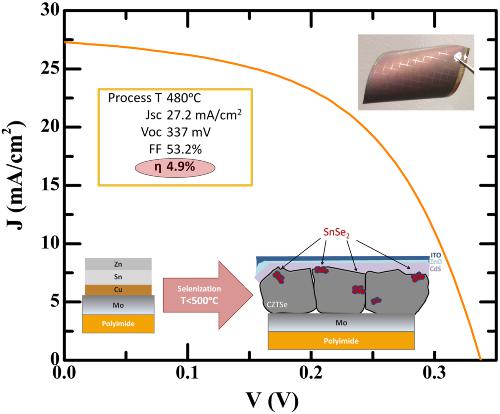当前位置:
X-MOL 学术
›
Prog. Photovoltaics
›
论文详情
Our official English website, www.x-mol.net, welcomes your
feedback! (Note: you will need to create a separate account there.)
CZTSe solar cells developed on polymer substrates: Effects of low‐temperature processing
Progress in Photovoltaics ( IF 8.0 ) Pub Date : 2017-10-05 , DOI: 10.1002/pip.2945 Ignacio Becerril-Romero 1 , Laura Acebo 1 , Florian Oliva 1 , Víctor Izquierdo-Roca 1 , Simón López-Marino 1 , Moisés Espíndola-Rodríguez 1 , Markus Neuschitzer 1 , Yudania Sánchez 1 , Marcel Placidi 1 , Alejandro Pérez-Rodríguez 1, 2 , Edgardo Saucedo 1 , Paul Pistor 1, 3
Progress in Photovoltaics ( IF 8.0 ) Pub Date : 2017-10-05 , DOI: 10.1002/pip.2945 Ignacio Becerril-Romero 1 , Laura Acebo 1 , Florian Oliva 1 , Víctor Izquierdo-Roca 1 , Simón López-Marino 1 , Moisés Espíndola-Rodríguez 1 , Markus Neuschitzer 1 , Yudania Sánchez 1 , Marcel Placidi 1 , Alejandro Pérez-Rodríguez 1, 2 , Edgardo Saucedo 1 , Paul Pistor 1, 3
Affiliation

|
Cu2ZnSn(S1−xSex)4 solar cells are well suited for roll‐to‐roll mass production since they are formed mainly by non‐toxic and earth‐abundant elements. Polyimide (PI) has proved to be a promising roll‐to‐roll compatible substrate yielding very high efficiency devices for Cu(In,Ga)Se2. In this work, we demonstrate the feasibility of using PI as a low‐weight and flexible alternative to soda‐lime glass for Cu2ZnSnSe4 (CZTSe) solar cells. Two main concerns arise when working with PI. Firstly, its low thermal robustness limits process temperatures below 500°C. The second concern is the lack of alkali in PI in contrast to conventional soda‐lime glass fundamental for high efficiency devices. This work tackles both issues. First, different alkali doping strategies are investigated for the incorporation of Na and K into CZTSe absorbers prepared on PI substrates by sequential precursor sputtering and selenization at 470°C: pre‐absorber synthesis and post‐deposition treatment. Post‐deposition treatment does not lead to an improvement of performance. Pre‐absorber synthesis effectively dopes the CZTSe absorbers increasing the solar cell performance and carrier concentration of the devices. Cu2ZnSnSe4 devices are then fabricated on glass and PI at different temperatures (450°C‐490°C). A detrimental SnSe2 secondary phase is detected in most of these devices. The formation of this phase is proved to be strongly related to process temperature. Despite this, a 6.4% efficiency device is achieved at 490°C on glass. Finally, through further experimentation and the addition of a Ge nanolayer, we report a 4.9% efficiency flexible device on PI setting a new record for kesterite solar cells on a polymer substrate.
中文翻译:

在聚合物基底上开发的CZTSe太阳能电池:低温处理的影响
Cu 2 ZnSn(S 1-x Se x)4太阳能电池非常适合卷对卷批量生产,因为它们主要由无毒且富含地球的元素形成。事实证明,聚酰亚胺(PI)是一种有前途的卷对卷兼容基板,可生产出非常高效的Cu(In,Ga)Se 2器件。在这项工作中,我们证明了使用PI作为Cu 2 ZnSnSe 4的钠钙玻璃的低重量且灵活的替代品的可行性。(CZTSe)太阳能电池。使用PI时,有两个主要问题。首先,它的低热稳定性将过程温度限制在500°C以下。第二个问题是与高效设备的传统钠钙玻璃相比,PI中缺乏碱。这项工作解决了两个问题。首先,研究了不同的碱掺杂策略,以通过顺序的前驱体溅射和470°C的硒化处理,将Na和K掺入在PI基底上制备的CZTSe吸收剂中:吸收剂合成和沉积后处理。沉积后处理不会改善性能。预吸收剂合成有效地掺杂了CZTSe吸收剂,从而提高了太阳能电池的性能和器件的载流子浓度。Cu 2 ZnSnSe 4然后在不同温度(450°C-490°C)的玻璃和PI上制造设备。在大多数此类设备中检测到有害的SnSe 2次级相。事实证明,该相的形成与工艺温度密切相关。尽管如此,在490°C的玻璃上仍可实现6.4%的效率。最后,通过进一步的实验和添加Ge纳米层,我们报道了在PI上效率为4.9%的柔性器件,为聚合物基板上的Kesterite太阳能电池创造了新记录。
更新日期:2017-10-05
中文翻译:

在聚合物基底上开发的CZTSe太阳能电池:低温处理的影响
Cu 2 ZnSn(S 1-x Se x)4太阳能电池非常适合卷对卷批量生产,因为它们主要由无毒且富含地球的元素形成。事实证明,聚酰亚胺(PI)是一种有前途的卷对卷兼容基板,可生产出非常高效的Cu(In,Ga)Se 2器件。在这项工作中,我们证明了使用PI作为Cu 2 ZnSnSe 4的钠钙玻璃的低重量且灵活的替代品的可行性。(CZTSe)太阳能电池。使用PI时,有两个主要问题。首先,它的低热稳定性将过程温度限制在500°C以下。第二个问题是与高效设备的传统钠钙玻璃相比,PI中缺乏碱。这项工作解决了两个问题。首先,研究了不同的碱掺杂策略,以通过顺序的前驱体溅射和470°C的硒化处理,将Na和K掺入在PI基底上制备的CZTSe吸收剂中:吸收剂合成和沉积后处理。沉积后处理不会改善性能。预吸收剂合成有效地掺杂了CZTSe吸收剂,从而提高了太阳能电池的性能和器件的载流子浓度。Cu 2 ZnSnSe 4然后在不同温度(450°C-490°C)的玻璃和PI上制造设备。在大多数此类设备中检测到有害的SnSe 2次级相。事实证明,该相的形成与工艺温度密切相关。尽管如此,在490°C的玻璃上仍可实现6.4%的效率。最后,通过进一步的实验和添加Ge纳米层,我们报道了在PI上效率为4.9%的柔性器件,为聚合物基板上的Kesterite太阳能电池创造了新记录。









































 京公网安备 11010802027423号
京公网安备 11010802027423号